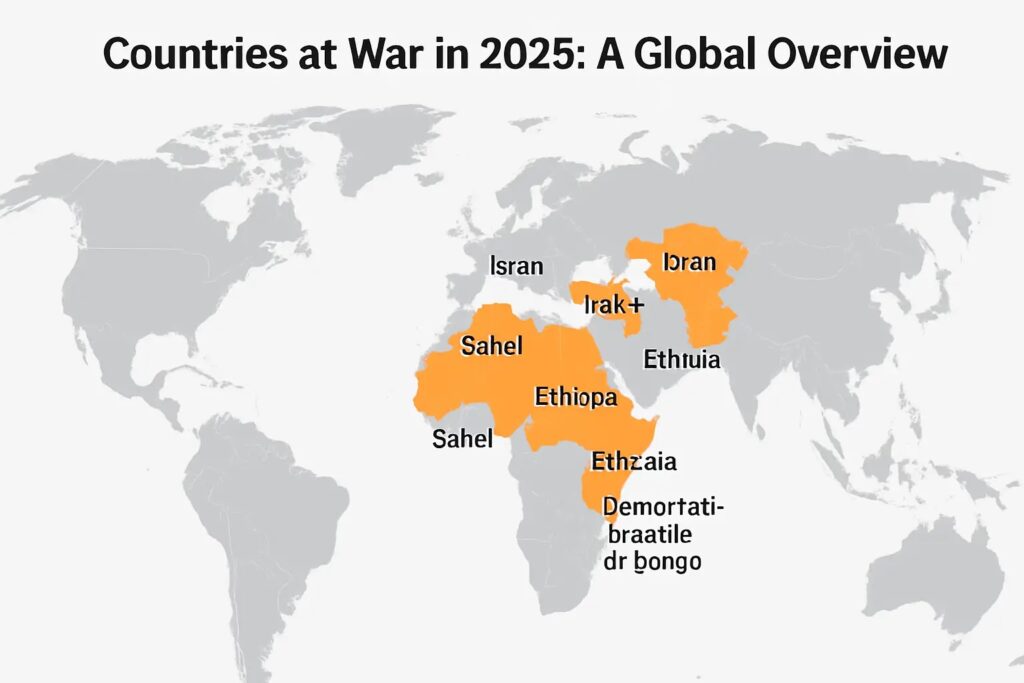Introduction: War in 2025
The world in 2025 faces multiple simultaneous conflicts, deeply affecting societies, economies, and regional stability. This article explores the key areas of tension, emerging trends, and the broader implications of these crises—all through a human lens.
Key Conflict Zones & Emerging Trends
Middle East & Israel–Iran Flare‑Up
A major escalation between Israel and Iran has shifted proxy tensions into direct military engagement—featuring airstrikes, cyberattacks, and missile exchanges. The ripple effects threaten regional security and global diplomacy.
Ukraine–Russia War
Despite a slight slowdown in hostilities, Ukraine remains under intense pressure from Russia’s campaign. The ongoing conflict continues to claim lives and devastate infrastructure, drawing sustained international attention and military aid.
Sudan’s Civil Conflict
Since April 2023, Sudan endures a brutal clash between the Sudanese Armed Forces and the Rapid Support Forces. With thousands killed and millions displaced, the country faces one of the world’s worst humanitarian crises.
Ethiopia’s Tigray Aftermath
Although active fighting in Tigray has subsided, Ethiopia still grapples with long-term consequences—displacement, communal tensions, and the slow path to recovery amid fragile peace.
DR Congo–Rwanda Tensions
The resurgence of conflict in eastern DR Congo—driven by rebel movements like M23 backed by Rwandan forces—has ignited fresh violence. The siege and fall of Goma highlight the region’s volatility and humanitarian urgency.
Australia’s Strategic Readiness
While not directly engaged in active combat, Australia plays a significant role in global security dynamics through strategic partnerships and defense readiness. In 2025, Australia deepened its alliance commitments—particularly through AUKUS—with expanded naval cooperation, joint military drills, and support roles in global evacuation operations. As tensions in the Indo-Pacific grow, Australia remains on high alert, balancing its diplomatic stance with growing defense investments and regional deterrence strategies.
Sahel Insurgencies
In Mali, Niger, and Burkina Faso, jihadist insurgents have seized vast territories. Frequent coups have shifted the regional balance of power, with increasing influence from non‑Western forces and worsening civilian suffering.
Broader Patterns & Shared Challenges
Proxy Warfare & Regional Domino Effects
Many conflicts in 2025 are defined by indirect warfare—regional rivals fund militia proxies. These indirect dynamics stretch instability across borders, complicating diplomatic solutions.
Humanitarian Fallout
Across the globe, wars leave deeper scars: famine, displacement, destroyed infrastructure, and halted social services are common. Humanitarian demands in places like Sudan and the Sahel have reached record highs.
Shifting Global Alliances
Wars in Africa and the Middle East have drawn in external powers—Russia, China, the Gulf states—reshaping traditional alignments and raising concerns about new spheres of influence.
Diplomatic Hurdles
From stalled ceasefires to failed peace talks, political solutions remain elusive. International mediators face resistance, entrenched interests, and fragmented national leadership.
What Lies Ahead
Increased External Pressure: Major powers may intensify involvement—providing arms, imposing sanctions, or brokering negotiations. Potential Escalation: Local conflicts risk erupting into wider regional wars, especially in the Middle East and Central Africa. Humanitarian Emergency: As violence spreads, aid networks will strain under growing demand for food, shelter, and medical relief.
Conclusion
The conflicts of 2025 are deeply interconnected, their impacts reaching beyond national borders. A thorough understanding of regional players, drivers of violence, and humanitarian urgency is essential for meaningful intervention and policy-making.

